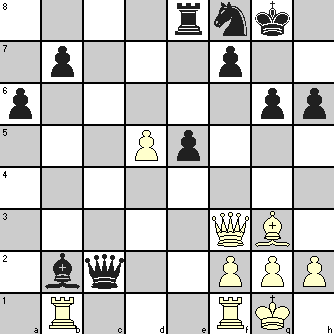We have already shown you how the power of the passed pawn can be used as a chess tactics in the middle game. The strength of this potent weapon cannot be overstressed. There are plenty of examples in master games where major pieces have been sacrificed to clear the path of a pawn to its promotion square.
A question may naturally arise as to the point in giving up a Queen (assuming that was the piece sacrificed) to promote a pawn to get back the Queen! The benefit may come in several ways.
We consider it a sacrifice when a Queen is exchanged with a few pawns or a minor piece or even a Rook. When you get back the Queen, your opponent does not get back his lost material. So you become a gainer to that extent.
Even when the Queen is given up without compensation, it may at least draw key offensive or defensive pieces away from their vantage points. The promoted Queen starts its life behind the enemy lines, so to say, and in the absence of the key pieces that have been diverted, it may attack the enemy position more effectively than the original Queen. That gives added advantage to you.
Sometimes a key square at opponent’s base line may not be directly accessible to your Queen and even when possible, the maneuvering you have to make may take considerable time. A passed pawn headed for that key square creates a Queen ready at the right position once the pawn gets promoted; all you need is to keep pushing it forward by removing the obstacles through timely sacrifices.
If you see some examples from master play, the concept will become quite clear. The illustrative game was played between Ludwig Engels and Geza Maroczy at the Dresden tournament of 1936.
Ludwig Engels (1905-1967) was an IM and one of the leading German players in the 1930’s. In the tournament where the present game was played, he came out second behind Alekhine. He was at Buenos Aires in 1939 as part of German team for the Chess Olympiad but got stranded due to the start of Second World War. He later moved to Brazil and settled in Sau Paolo as a trainer in Sao Paolo Chess Club.
We have introduced you to Maroczy in connection with another use of sacrifice in Chess Sacrifice as a Chess Tactics: breaking the walls of the castle! As luck would have it, in that example also Maroczy happened to be at the receiving end!
The diagram shows the position after 24 moves have been completed and White is now aware of the potential of the passed QP that is now in his possession. His subsequent play is all aimed at promoting this passed pawn.

| 25. | Qd1 | Rc8 | ||
| 26. | d6 | Nd7 | Black has thrown a lot of obstacles in the pawn’s path, but White has seen the way around those | |
| 27. | Qg4 | Nb6 | Black is also ready to counter the pawn’s advance | |
| 28. | Rxb2! | Qxb2 | The first surprise salvo by White, giving up the Rook for a Bishop | |
| 29. | Qxc8+ | Nxc8 | The second salvo, sacrificing the Queen for a Rook. If Black tries to move the King away instead of capturing the Queen, White becomes the gainer of a full Rook! But once the Queen is taken, the pawn’s path is clear! | |
| 30. | d7 | Resigns | The problem for Black is that the Pawn has got two promotion squares, 31. dxc8=Q or 31. d8=Q! No way Black can guard both the squares. And with the White Queen at the backyard with a check and the Rook and Bishop ready to come out in support, Black’s two passed pawns have no time to pose any threat. |
Watch the Game


One Comment
An interesting piece which unleashes yet another special feature of the pawns, especially passed pawn, Thanks for the post.
Trackbacks/Pingbacks